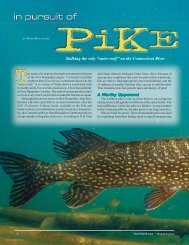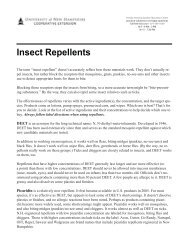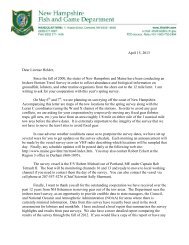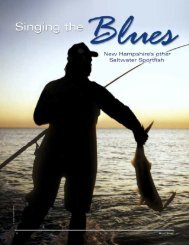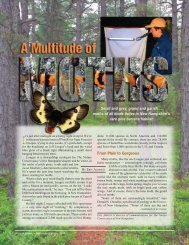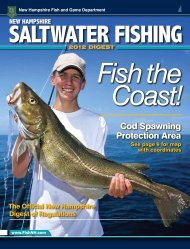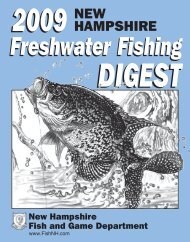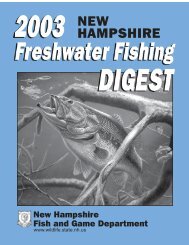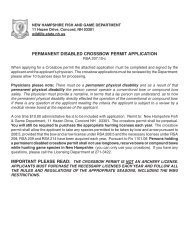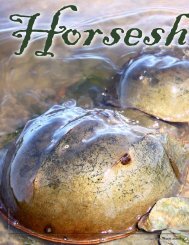Official NH Digest of Regulations - New Hampshire Fish and Game ...
Official NH Digest of Regulations - New Hampshire Fish and Game ...
Official NH Digest of Regulations - New Hampshire Fish and Game ...
You also want an ePaper? Increase the reach of your titles
YUMPU automatically turns print PDFs into web optimized ePapers that Google loves.
Flounder Identification<br />
Three features distinguish the four major flounder caught recreationally<br />
along <strong>New</strong> <strong>Hampshire</strong>’s coast: orientation <strong>of</strong> the eyes (right- or lefteyed);<br />
mouth size; <strong>and</strong> shape <strong>of</strong> the lateral line. Recreational<br />
saltwater anglers in N.H. most commonly catch winter flounder,<br />
followed by yellowtail, summer flounder <strong>and</strong> American plaice.<br />
Arched<br />
lateral line<br />
Winter Flounder<br />
(12" minimum length)<br />
• Eyes on right side<br />
• Small mouth<br />
• Scales between eyes<br />
Yellowtail Flounder<br />
(13" minimum length)<br />
• Eyes on right side<br />
• Small mouth<br />
American Plaice<br />
(14" minimum length)<br />
• Eyes on right side<br />
• Large mouth<br />
Summer Flounder<br />
(15" minimum length)<br />
• Eyes on left side<br />
• Large mouth<br />
• Sharp teeth<br />
Catch & Release<br />
• Time is <strong>of</strong> the essence. Play <strong>and</strong> release the fish as quickly<br />
<strong>and</strong> carefully as possible. An overplayed fish may become too<br />
weak to recover.<br />
• When l<strong>and</strong>ing fish, use a net with fine mesh to avoid injury.<br />
A net is probably not necessary for small fish. Keep the fish in<br />
the water as much as possible. A fish out <strong>of</strong> water is suffocating<br />
<strong>and</strong> could be injured.<br />
• When releasing a fish, try not to touch it when removing the hook<br />
<strong>and</strong> releasing it. When h<strong>and</strong>ling the fish, do not let it flop around<br />
or squeeze it. The fish can be gently held around the middle <strong>and</strong><br />
upside down while removing the hook. This position calms the<br />
fish <strong>and</strong> deters it from moving around.<br />
• Remove the hook with small pliers or by using the thumb <strong>and</strong><br />
forefinger to loosen <strong>and</strong> back out the hook. If a hook cannot be<br />
easily removed, cut the leader as close as possible to the hook.<br />
The hook will rust or fall out in a short time.<br />
• To revive a tired fish, hold it in a swimming position with one h<strong>and</strong><br />
under its bottom jaw <strong>and</strong> the other h<strong>and</strong> grasping the fish in front<br />
<strong>of</strong> the tail. Gently move the fish back <strong>and</strong> forth through the water<br />
until it is able to swim away.<br />
The <strong>New</strong> <strong>Hampshire</strong> <strong>Fish</strong> <strong>and</strong> <strong>Game</strong> Department recommends that<br />
anglers who plan to use live or cut bait when fishing for striped bass<br />
or other fish use circle hooks to reduce mortality on fish that will<br />
be released. Studies comparing baited circle hooks to the st<strong>and</strong>ard<br />
J hooks used by most anglers show a substantial reduction in<br />
the post-release hooking mortality when circle hooks are used.<br />
For more information, contact <strong>Fish</strong> <strong>and</strong> <strong>Game</strong> Marine <strong>Fish</strong>eries<br />
Division weekdays (8:00 a.m. – 4:00 p.m.) at (603) 868-1095.<br />
www.<strong>Fish</strong><strong>NH</strong>.com 9



